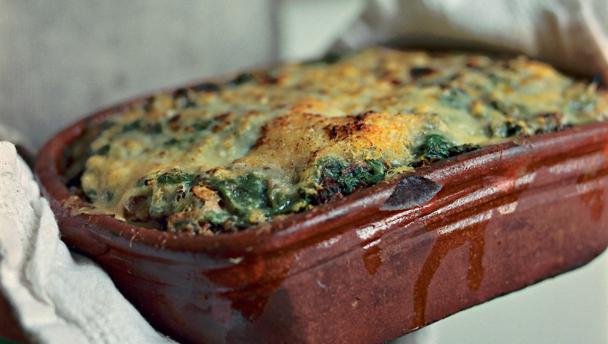

By Sophie Grigson
This member of the beet family has large, flat, crinkled green leaves with thick, fleshy stalks and ribs. The taste is rich, complex and robust. Think of chard almost as two vegetables in one as both the leaves and stems can be used. Swiss chard is popular in Italian and French cooking.
Swiss chard is also called chard, leaf beet, seakale beet, white beet and spinach beet. Different varieties may have red, pink, white or yellow stalks, rub chard has red ribs, for example.
 Beer-marinated rack of pork with Swiss-chard gratin
Beer-marinated rack of pork with Swiss-chard gratin
 Chicory gratin
Chicory gratin
 Pork meatballs with anchovies
Pork meatballs with anchovies
 Griddled lamb chops with inzimino
Griddled lamb chops with inzimino
Swiss chard is in season fro June to August, and from October to April.
Look for rainbow varieties of chard at farmers’ markets or farm shops. Choose fresh-looking bunches with bright, glossy leaves and firm, unblemished stalks. Reject any that are starting to yellow.
Chard needs to be stored in a moist, cool atmosphere. Store it unwashed: wrapped in damp kitchen paper and place in a plastic bag in the salad drawer of the fridge. Use within a few days. Chard leaves freeze well, but the stems become soggy. Wash the leaves well, blanch, drain, then plunge into iced water. Drain again and pack into freezer bags, then label and seal. Cook from frozen.
The stem is often steamed and served separately. The leaves cook more quickly than the stem and can be added to soups, flans, tarts and omelettes. They are also sometimes used as a substitute for spinach. Both stem and leaves can be sautéed with cream, butter and cheese. Wash well, before use, to remove any grit, and trim only when ready to cook.
Article by Clarissa Hyman
Type the ingredients you want to use, then click Go. For better results you can use quotation marks around phrases (e.g. "chicken breast"). Alternatively you can search by chef, programme, cuisine, diet, or dish (e.g. Lasagne).